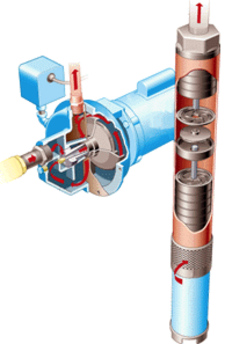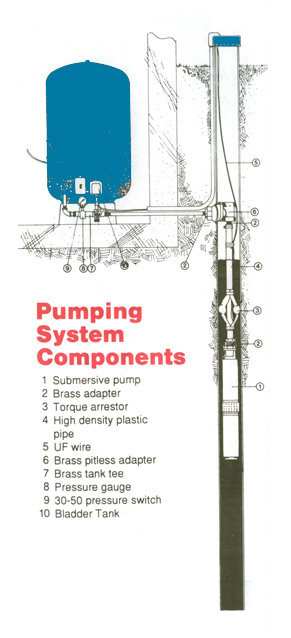Call us!
(979) 627-5188
Lic. # 59348
Pumps: Submersible Pumps
We install submersible pumps & pressure tanks.
We carry a complete line of submersible pumps. Our trucks are stocked to respond to your service call immediately to restore your water quickly. We service all brands of submersible pumps.
We take care to provide our customers high quality, best in class water well service, installation & repair. Our staff members are professional, courteous and efficient. Our goal is prompt & professional service.
Motors: 0.75 HP - 5+ HP
We carry a complete line of motors of various different sizes - 0.75 HP - 5+ HP. Our trucks are stocked and ready to respond to your call.
Tanks: Captive Air (Pre Charged, Bladder)
We carry a complete line of captive air & galvanized tanks.
If you live in a town or city, you probably don't give much thought to how the water you use each day gets to your house. Even small villages often provide a network of supply pipes that transport water to each home in the neighborhood. All you need to know is how to open the tap at the sink.
Move a few miles out of town and the picture can change. While the inner workings are still—thankfully—invisible, your water supply is independent from the neighbor's down the road. Each home has its own well from which to draw water. More than that, each home has its own electromechanical system for getting the water from the well to the house. At the heart of each system is a pump, and the most common types are jet pumps and submersible pumps.
Well types
In many areas of the country, finding potable water is as easy as getting out a shovel and digging a hole in the ground. Okay, maybe "easy" isn't the right word, but wherever the water table is only several feet below the surface of the ground, part of the battle may already be over. In such a shallow-well situation, lifting the water up to the house is going to be a little easier, if only because the distance you have to move it is modest.
If your area doesn't have a high water table, or if it lacks a stable supply of potable water near the surface, you must dig deeper to achieve the same result. And because a deep well means that the water has to be lifted farther, the strategies for moving it change.
Shallow-well pumps
These days, the most common pump for a shallow well is a jet pump. Jet pumps are mounted above the well, either in the home or in a well house, and draw the water up from the well through suction (see Single-Drop Jet-Pump System diagram on next page). Because suction is involved, atmospheric pressure is what's really doing the work. Think of the system as a long straw. As you suck on the straw, you create a vacuum in the straw above the water. Once the vacuum is there, the weight of the air, or atmospheric pressure, pushes the water up the straw. Consequently, the height that you can lift the water with a shallow-well jet pump relates to the weight of the air. While air pressure varies with elevation, it's common to limit the depth of a jet-pump-operated shallow well to about 25 ft.
Jet pumps create suction in a rather novel way. The pump is powered by an electric motor that drives an impeller, or centrifugal pump. The impeller moves water, called drive water, from the well through a narrow orifice, or jet, mounted in the housing in front of the impeller. This constriction at the jet causes the speed of the moving water to increase, much like the nozzle on a garden hose. As the water leaves the jet, a partial vacuum is created that sucks additional water from the well. Directly behind the jet is a Venturi tube that increases in diameter. Its function is to slow down the water and increase the pressure. The pumped water–new water that's drawn from the well by the suction at the jet–then combines with the drive water to discharge into the plumbing system at high pressure.
Because shallow-well jet pumps use water to draw water, they generally need to be primed–filled with water–before they'll work. To keep water in the pump and plumbing system from flowing back down into the well, a 1-way check valve is installed in the feed line to the pump.
Breaking the depth barrier
Unfortunately, you may have to go a little deeper than 25 ft. for your water. Surprisingly, you can still do it with a jet pump. It simply involves separating the jet from the motor and impeller housing and placing the jet assembly down in the water (see Double-Drop Jet-Pump System diagram). In a typical deep-well jet-pump configuration, one pipe mounted to the impeller housing drives water down into the jet body that's located about 10 to 20 ft. below the minimum well water level. A second pipe connects the output side of the jet body back to the pump.
At the jet, the increase in water velocity creates the partial vacuum that draws standing well water into the second pipe and then back into the pump and plumbing system. Deep-well jet pumps use both the suction at the jet to bring water into the system and pressure applied by the impeller to lift the water.
To prevent overpumping the well, a deep-well jet-pump installation may include a 35-ft.-long tailpipe. It's connected to the intake end of the jet housing and extends down into the well. If the water level dips below the level of the jet housing, the pump operates in the same manner that a shallow-well pump does. While flow rate drops off, water will be available until the level drops below about 25 ft. from the jet housing-the limit for a shallow pump. The 35-ft.-long tailpipe effectively ensures that the well will never be pumped out. Of course, the height of the jet over the water level affects performance. The farther away it is, the less efficient the pumping becomes.
Like shallow-well systems, a jet pump in a deep-well system needs to be primed to operate. A foot valve at the bottom of the well piping prevents water from draining from the pipes and pump. Jet pumps that have two or more impellers are called multistage pumps.
Moving to the source
While a jet pump can reliably handle a well several hundred feet deep, a more effective solution is to move the pump down into the well so, instead of lifting the water, it's pushing it up. A typical submersible pump is characterized by a long cylindrical shape that fits inside the well casing. The bottom half is made up of a sealed pump motor that is connected to the aboveground power source and controlled by wires. The actual pump half of the unit is comprised of a stacked series of impellers-each separated by a diffuser-that drives the water up the pipe to the plumbing system.
In modern installations, the well casing outside the home is connected to the plumbing system by a pipe that runs beneath the ground to the basement (see Submersible Pump System diagram). This horizontal pipe joins the well pipe at a connector called a pitless adapter. The function of the adapter is to permit access to the pump and well piping through the top of the well casing, while routing water from the pump into the plumbing system.
While submersible pumps are more efficient than jet pumps in delivering more water for the same size motor, pump or motor problems will necessitate pulling the unit from the well casing-a job that's best left to a pro. However, submersibles are known for their reliability and often perform their role 20 to 25 years without servicing. Submersible pumps may also be used in shallow wells. However, silt, sand, algae and other contaminants can shorten the pump's life.
Common elements
No matter what kind of system you have, the components on the output side of all pumps are similar.
Pumps are not intended to run continuously, and they don't start each time you open a tap or flush the toilet. In order to provide consistent water pressure at the fixtures, the pump first moves water to a storage tank. Inside a modern tank is an air bladder that becomes compressed as the water is pumped in. The pressure in the tank is what moves the water through the household plumbing system.
When the pressure reaches a preset level, which can be anywhere from 40 to 60 psi, a switch stops the pump. As water is used in the home, pressure begins to decrease until, after a drop of about 20 psi, the switch turns on the pump and the cycle is repeated. You'll find the pressure gauge mounted on the tank with wires leading to the switch that controls the pump.
To Read more: Water Well Pumps and Systems - How a Water Well Pump Works - Popular Mechanics
How it works: Water Well Pump
Submersible Pump
Jet Pump
Other: Control Boxes & Accessories; Lake Pumps
We also service pressure switches, check valves, control boxes & accessories as well as all brands of lake pumps.
Typical Submersible System
Pump Types


